Antonioni says that his films of the early sixties are about the “Spiritual Aridity” and “Moral Decay” of the upper classes of post war Italian society. This lack of spirituality and moral decay is a result of the character’s inner alienation. Here I will explore how the director uses various filmic devices to communicate the idea of the characters alienation to the audience. I will also discuss the character’s impossibility to love and communicate with each other and how the setting and architecture can comment on the character’s state of mind.
The Impossibility of Love / Communication
“Why do we ask so many questions? Two people shouldn’t know each other too well if they want to fall in love.” – Vittoria in L’Eclisse
Men and equally women in Antonioni’s trilogy of moral decay believe that sex is the answer to their loneliness and emptiness. If they are feeling alone, they want sex to fill the void. For example in L’Avventura when they are on the island of Lista Bianca, Anna is talking to Sandro about her troubles and their problems of miscommunication. This is actually moral progress in her character; she is talking about her feelings, not covering them up with false love as she had the day before. Anna was the one who initiated sex between them at Sandro’s apartment. She believed that making love to Sandro would fill up her void and make all their problems disappear. She tells Sandro that she does not know if she loves him anymore. Sandro replies by bringing up the fact that they had sex the day before by saying “Even yesterday, at my place, you didn’t feel me anymore?” A clear sign that he is not progressing as a human being. His morals and faults will never change.
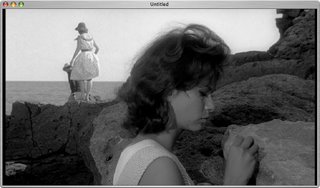
What I find interesting in this scene when they are talking about their problems on the island we have a deep focus shot, and in the background Julia and Corrado walk by. Antonioni is paralleling these two couples and telling us that they have the same problems of miscommunication, and that they are in the same situation.
In fact all couples in L’Avventura have the same problems. They cannot communicate, or love each other. Antonioni is commenting on marriage in modern times. For example, a newly married couple that work in the pharmacy Sandro goes to visit are always shown disagreeing and they have only been married for three months. There is also a scene in t
 he train when Claudia is listening to a young man trying to pick-up a young lady. They are complete opposites in what they like. One prefers love, the other music etc… And the couple the most separated from each other are: Corrado & Julia. Corrado constantly belittles Julia for the things she says and does. It is very rare that we see these two characters close to one another. They are always framed at opposite ends of the screen, or not looking directly at one another.
he train when Claudia is listening to a young man trying to pick-up a young lady. They are complete opposites in what they like. One prefers love, the other music etc… And the couple the most separated from each other are: Corrado & Julia. Corrado constantly belittles Julia for the things she says and does. It is very rare that we see these two characters close to one another. They are always framed at opposite ends of the screen, or not looking directly at one another.In L’Eclisse Vittoria goes to the stock exchange to speak to her mother about the breakup with Riccardo, yet she never gets to tell her. Her mother is too happy to think of anything else except the millions she just made. Vittoria’s relationship with her own family is shaky. They obviously have different values.
In La Notte Valentina (again played by Vitti) is afraid of love. There is a scene where Giovanni and Valentina just finished listening to a recording in her bedroom. She is standing in the light. He then professes his love for her where at this point she backs up into darkness as if to say that she does not want love.

Her position before Giovanni says he wants Valentina
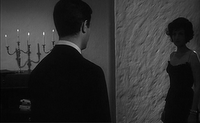
Her position in frame / light after his confession
Moral Decay / Alienation
“You’ve lost weight” – Anita “Yes, from the inside” – Vittoria (from L’Eclisse)
Antonioni often frames his characters standing alone against an empty
 wall to signify their loneliness. An example of this is in La Notte when the nymphomaniac is looking at Giovanni. “What the nymphomaniac wants to shut out is any knowledge of the blank immensity … that we see exteriorized as she stands against the absolutely clinical white blankness of the wall, her own emptiness projected as the emptiness around her, threatening her.” 1 She sees an opportunity to forget about her isolation, to be touched and to touch and she madly takes it. What is demoralizing to Giovanni is not this woman wants him, but that he gives in to her advances.
wall to signify their loneliness. An example of this is in La Notte when the nymphomaniac is looking at Giovanni. “What the nymphomaniac wants to shut out is any knowledge of the blank immensity … that we see exteriorized as she stands against the absolutely clinical white blankness of the wall, her own emptiness projected as the emptiness around her, threatening her.” 1 She sees an opportunity to forget about her isolation, to be touched and to touch and she madly takes it. What is demoralizing to Giovanni is not this woman wants him, but that he gives in to her advances.In L’Avventura there is a scene where Sandro jumps on the train to follow Claudia. As they talk Sandro says he has “no intention of sacrificing himself.” Here we have to wonder what kind of morals this character has based on what he just said. He lost his girlfriend / almost fiancée Anna just the previous day and he is already chasing after another woman. He wants to give up looking for the woman he loves. Why is he doing this? He is empty, maybe too lazy to put forth the effort of looking for her. We get the impression that Sandro cannot be alone at all. The notion of being alone scares him. He later proposes marriage to Claudia after only knowing her for three days. He is the complete opposite of a minor character in the film: the Australian on the island. This man is comforted by the fact that he has relatives that love him even though they are oceans apart.
Getting back to the scene on the train, we have another story for Claudia. She cannot easily let go of Anna like Sandro has. She says that things are moving so fast, and this is reflected in the mise-en-scene. They are having this discussion in a train (a fast method of transportation) and Claudia is standing against a glass door and the background is quickly passing behind her, suggesting the quick changing events that are happening in her life.
“The character’s are active only in trying to discharge their anxiety: Sex is their sole means of contact” – Pauline Kael
The idea of sex crazy men is pushed to the extreme when Sandro goes looking for the reporter who published the story of Anna’s disappearance. It is set against a backdrop of hundreds of sex-starved men who have come to see “Gloria Perkins” a famous celebrity. It draws a great parallel between Sandro and these young men. Although they annoy him, he is no different. He asks the reporter to publish a false story on the whereabouts of Anna, knowing that when this is done, Claudia will see the story and come looking for her as well, allowing Sandro to make another attempt at the fragile Claudia.
At the end of La Notte, Giovanni is listening to Lidia read an old love letter he wrote, he is suddenly confronted with the painful realization that his youth and his once powerful love for Lidia has vanished. He then tries to smother that excruciating awareness by forcing himself upon her. 2 Here again sex is used as a method to cover up one’s emptiness.
The same scene happens in L’Avventura after Sandro deliberately spills ink on the young architect’s drawing. This obvious fit of jealousy is his cry for selling his soul for the thing he loves most, which is classical architecture. After this moment of emptiness he goes back to the hotel and he forces himself upon Claudia.
We get the sense that the characters are half human. They need another human to complete them. The filmic language suggests that Anna and Claudia together make a whole person. They are complete opposites, from their attitude, hair color, social standing and wardrobe. Antonioni often frames them with one facing the camera and another with their back to it. This transformation of Claudia wanting to become Anna gradually continues throughout the film where eventually Claudia will take the place of Anna as Sandro’s new lover. For example, she wears Anna’s shirt after her disappearance, and even tries on a black wig to look like Anna. Her transformation into Anna is very gradual and one can see it in the wardrobe throughout the film. At the beginning of the film Anna is wearing a white dress, and Claudia is in black. (fig 1.) As said before she later changes into a not exactly solid black (Anna’s) shirt. (fig. 2) When she meets Sandro at the pharmacy to go on their search she is wearing a black shirt with white polka dots on it. (fig. 3) After their stay at the hotel she is wearing a gray suit, (fig. 4) until finally at the end before Sandro’s affair she is wearing all white. (fig. 5) She has finally become Anna’s equal. A woman in Sandro’s back pocket, and I believe it is because he knows this that he cheats on her. She then goes back to her original wardrobe wearing black. (fig. 6) Has she found herself? Was she ever really lost?
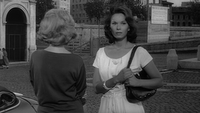

Fig.1 Fig. 2
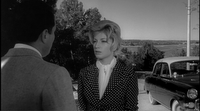

Fig. 3 Fig. 4


Fig. 5 Fig. 6
In L’Eclisse Antonioni is showing us that Vittoria is not a complete person unless she has a man to love her as well. This is shown through the shot where people ar
 e silent in the stock exchange and Vittoria’s face is half exposed behind a pillar and Piero’s face is exposed on the right half. This framing signifies that they are not whole without each other. After this point whenever these two characters meet, they are at construction sites. She is standing next to an empty building in the midst of being build, or that has been abandoned. These buildings and environment is representative of Piero and Vittoria, empty and incomplete.
e silent in the stock exchange and Vittoria’s face is half exposed behind a pillar and Piero’s face is exposed on the right half. This framing signifies that they are not whole without each other. After this point whenever these two characters meet, they are at construction sites. She is standing next to an empty building in the midst of being build, or that has been abandoned. These buildings and environment is representative of Piero and Vittoria, empty and incomplete.In L’Avventura an example of lost morality is displayed at the princesses’ mansion when the secondary characters are having tea on the patio outside & Claudia is standing by. One woman comments that she does not know Sandro and that “maybe he’s done away with her.” They are talking like Anna was a lost dog, or perhaps she was like the pottery that was found on the island, here one day, broken the next. All the characters on the boat continue with their plans to enjoy their upper class getaway. They do not let a friend’s death / disappearance get in the way of their fun. This is the most obvious comment in the film that post war Italian society has lost it’s morals.
L’Eclisse gradually shows us that Piero has no morals. From the beginning when the workers at the stock exchange are asked for a minute of silence for a colleague that past on, Piero cannot keep quiet and comments to Vittoria that “here a minute costs billions.” Yet when they were together in his office, he disconnected all the phones to be with her. Could this be a sign that he loves her? Yet after she leaves and he puts all the phones back on their receivers, he then pauses and thinks. One could almost read his mind: “How much does it cost to fall in love, is it worth the price?” The film’s ending answers this question.
Piero also treats women and sex like a commodity. While at work he orders a call girl and when they later meet he refuses her because she had changed the color of her hair. He sends her back like a bought good.
To Vittoria men are object’s or possessions, like the one’s she is placing in the frame at the film’s opening. They are like pawns on a chessboard and it is up to her where they stand in her life. She later says in the film “Holding a needle, a book or a man are all the same thing.” The
 mise-en-scene in the opening shot objectifies Riccardo at multiple intervals. The opening shot he is static and still like a statue, or a piece of furniture in the room. At times his head is cut off by a lampshade, suggesting that he is an object. To reinforce the point that Vittoria believes men are commodities, later in the film she learns that a particular man lost 50 million dollars. She might be feeling guilty that she feels no sense of sadness at losing Ricardo, so what does one do when one looses so much? She does not know, so she decides to takes a lesson from this man and follow him. Except he lost money, not a lover, therefore no lesson is learnt.
mise-en-scene in the opening shot objectifies Riccardo at multiple intervals. The opening shot he is static and still like a statue, or a piece of furniture in the room. At times his head is cut off by a lampshade, suggesting that he is an object. To reinforce the point that Vittoria believes men are commodities, later in the film she learns that a particular man lost 50 million dollars. She might be feeling guilty that she feels no sense of sadness at losing Ricardo, so what does one do when one looses so much? She does not know, so she decides to takes a lesson from this man and follow him. Except he lost money, not a lover, therefore no lesson is learnt.How Location and Architecture Comment on Character’s State of Mind
"Juxtaposing a person with an environment that is boundless, collating him with a countless number of people passing by close to him and far away, relating a person to the whole world, that is the meaning of cinema."
- Andrei Tarkovsky
Vittoria is never really happy L’Eclisse. There are however times when she gives us temporary moments of happiness like in the airplane. She feels liberated for those moments in the clouds, but she is in a closed in space, so how free can she be? The sky is a symbol of heaven. This is a place people go when they die. So it is a pretty grim place to make her smile. Antonioni is asking can we be truly happy in life? Even after she gets off the plane, she decides not to follow her “friends”. She stays behind, framed all by herself in this vast expansive air landing strip. She has no sense of belonging to a group in fact alienating herself. Alienation is defined as “the state or experience of being isolated from a group or activity to which one should belong or which one should be involved.”

Later when Vittoria and her neighbor visits the woman across the streets apartment Vittoria is framed from behind looking at pictures of these foreign landscapes as if she wants to escape and be there. She then later takes it one step further by dressing up like an African tribal woman. These actions are to symbolize her want for escape, to be someone else, to maybe go to a place where relationships are fixed (arranged marriages)
In L’Avventura Claudia and Sandro visit “Noto” a village in which they believe Anna might be hiding. Upon arrival and further investigation they find the town to be de
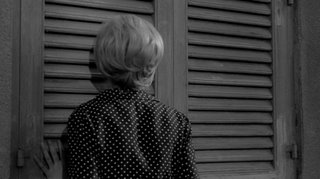 solate. The landscape and architecture around them represents who they are as people: empty and deserted. The medium shot of Claudia with her back turned towards the audience furthers this notion of alienation and self-entrapment. First we have a frame of concrete from the building around her, next the window frame, the horizontal shutters of the window, representing that she is imprisoned. Antonioni does not need to frame her behind shutters to be imprisoned, because her life is one, she is on the side of the prison, she wants what is in this building (Anna, or maybe an answer?) which could maybe lead her to some sort of salvation.
solate. The landscape and architecture around them represents who they are as people: empty and deserted. The medium shot of Claudia with her back turned towards the audience furthers this notion of alienation and self-entrapment. First we have a frame of concrete from the building around her, next the window frame, the horizontal shutters of the window, representing that she is imprisoned. Antonioni does not need to frame her behind shutters to be imprisoned, because her life is one, she is on the side of the prison, she wants what is in this building (Anna, or maybe an answer?) which could maybe lead her to some sort of salvation.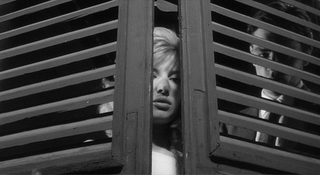
The reverse situation is used in L’Eclisse. There is a scene when Vittoria goes over to Piero’s parent’s apartment. She looks outside and Antonioni gives us a reverse angle and we have Vittoria framed through the horizontal bars of the shutters. She is feeling imprisoned and perhaps does not want to be there. However a thought as serious as this can only last for a moment in the mind of Vittoria, until something else grabs her attention.
Antonioni will often set his characters against massive landscapes to “emphasize the smallness of his characters in relation to their surroundings. Even in a simple outdoor café, in L’Eclisse: as the two characters cross the patio, the camera tilts slowly upward, cutting off their feet, thus simultaneously severing their connection to the earth and relating them to the expansive sky above. 4
Characters in Antonioni’s films tend to wander, and the locations they wander in are representative of their frame of mind. For example in Blow-up Thomas the photographer is often alone, there is a long scene at the end where he wanders to find his agent. He goes to a concert, a party, then to the park; although there are people around him he is alone, as he does not have any real relationships in these settings, or anywhere in his life for that matter.
In L’Avventura Sandro and Claudia were always located in a geographically “high” location when there is some sort of emotional connection. The first is on the island when he holds her hand after she splashes some water on her face. The second is at the pharmacy when she gets into Sandro’s car to begin this excursion with him. We clearly see the sea in deep focus in the far background as the chauffeur’s car passes behind them to go downhill. Three when they make love outside they are overlooking a valley. And last is the last shot of the film where they are overlooking Mount Edna and we have that last emotional connection between the two. These 4 locations can be the four stages in Claudia’s discovery of herself. The first being the idea that they can be a couple. The second is where she has lost a friend so she feels she needs the love of a man and therefore the couple forms. The third is the couples confirmation of “love”, her filling the void of lost Anna, by becoming Anna, thinking this new life will bring her happiness. The last being her self-realization that she does not need Sandro, she can forgive him for his faults, but she knows this is not the life she wants to lead. L’Avventura has a happy and hopeful ending for Claudia but not for Sandro. The left side of the frame being Claudia’s side, has the volcano which can represent possibility confirms this is a happy ending for her. And the blank brick wall, which characters are often framed against when they are lonely is on Sandro’s side.
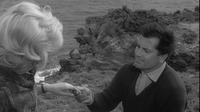
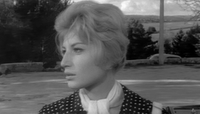


Footnotes:
1 Arrowsmith, William Antonioni: The Poet of Images New York: Oxford University Press 1995
2 Introduction – Concordia University Studies in Film Directors Course Pack page 153
4 Unknown author. http://restlesspictures.blogspot.com/2005/04/antonioni.html (December 5, 2005)
No comments:
Post a Comment